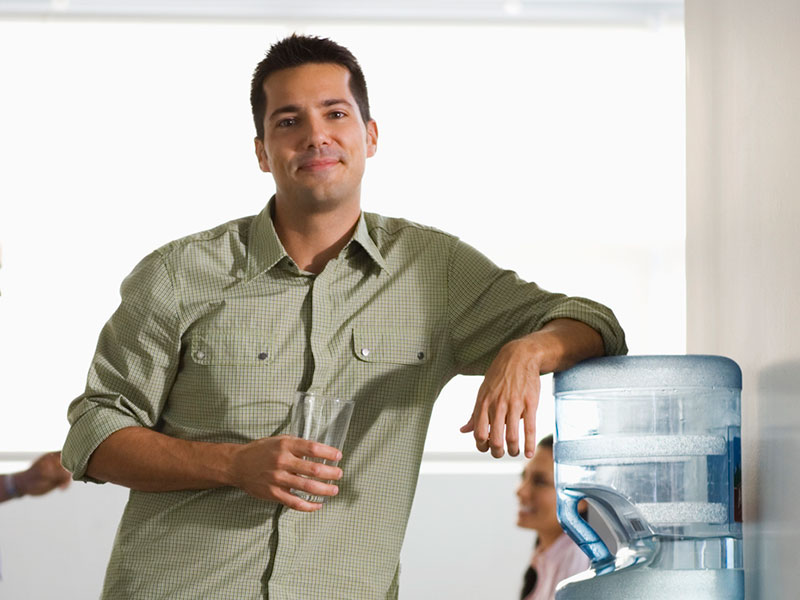How To Clean Your Water Dispenser

Maybe you live in an area without access to clean, potable tap water, or perhaps your region has very mineralized water, and you prefer purified drinking water.
In either case, chances are that you have to order bottled drinking water and have a water dispenser. If you do, you know that owning the water dispenser makes your life a lot easier.
However, you may not know that most dispenser manufacturers and government health authorities recommend cleaning your dispenser fairly frequently, about once every 6 weeks or upon arrival of a new water bottle, whichever is sooner.
In order to help you get this job done, in this article we describe the process of cleaning a basic water dispenser (also sometimes called a cooler).
Steps To Clean A Water Dispenser
Once you’ve gathered all the required supplies, it’s time to start your prep work for your cleaning task. We’re going to start by making the cleaning solution you’ll be using later.
Start by pouring about a gallon of drinkable water into a large bucket. From here, it’s up to you whether you want to use the bleach or vinegar option. Bleach is powerful, but vinegar gets the job done and consumption isn’t toxic to humans.
If you go the bleach route, mix about a tablespoon of bleach for each gallon of water in your bucket. Unscented bleach is the more desirable option for this job, as your cooler won’t smell after you’re done cleaning. For safety, we recommend using disposable gloves and to mix the solution in an area without spill risk (like a sink).
When creating the vinegar solution, mix one part undiluted vinegar for every 3 parts of water. For a gallon of water, this means adding just over 5 cups of vinegar. You can also add a tablespoon or so of lemon juice to offset the strong smell of vinegar if you wish.
Once you’ve made your desired solution, it’s time to get started on cleaning your dispenser. Start by unplugging the unit from the power source. Then remove the empty bottle from the dispenser, if one is there. Trust us when we say that your life will be a whole lot easier if you don’t try to clean your dispenser when the water bottle is full.
You can also use the cold water tap (also called a spigot) on the dispenser to drain out any potable water still left in the system, which can be drunk or otherwise used.
If your water dispenser has a water guard (which punctures the lid of new water bottles), remove it. Not all coolers have water guards, so don’t be alarmed if you can’t find one.
Similarly, remove the baffle, which is the component that covers the reservoir inside the dispenser. Clean these parts using warm water, a cloth or sponge, and mild dish soap, as you would when cleaning dishes by hand. You may also use your cleaning solution on these parts, provided you rinse them well afterward.
Use a sponge to soak up some of the cleaning solution and gently scrub the reservoir of the water cooler. You can also partly fill the reservoir with a cleaning solution. If you are using the bleach solution, be sure to use gloves. Let the solution drain into the dispenser and let it sit for 2-5 minutes. Be sure not to let it stand for more than 5 minutes, to ensure no corrosive damage.
Then, drain the solution through the cold water tap/spigot and into a separate container, which you can then dispose of down the toilet.
The next step is to flush the system with clean water several times over, to make sure no vinegar or bleach remains. Rinse the reservoir as thoroughly as you can, at least 3 times, running the excess water through the system, into a container, and then into a toilet or sink to be disposed of.
Once you’ve flushed the system well, and the water guard and baffle have been rinsed and dried, put the dispenser back together.
You can also clean the outside components of your dispenser by using a warm, soapy cloth or sponge. This is a good idea for a periodic cleaning of the drip tray, spigot paddles, and the rest of the outside surface of the cooler.
All that’s left now is to put the new water bottle on the cooler, press the spigots to make sure water is flowing, and then plug the unit back into a power source.
A Clean Water Cooler
Our last step in the process is to test the water to make sure that no residual, unwanted tastes remain. If it does, revisit flushing the reservoir until the water taste returns to normal.
Once you’ve cleaned your water cooler, you can rest easy that you’re drinking wonderfully clean, purified water.

